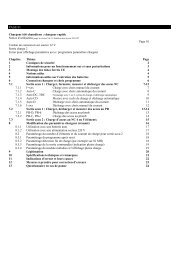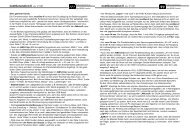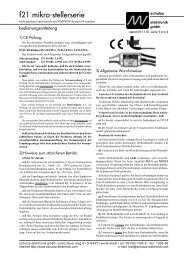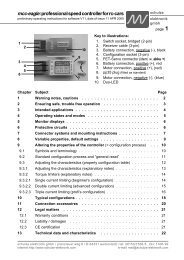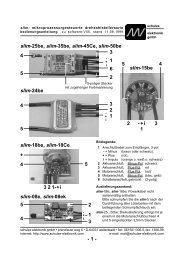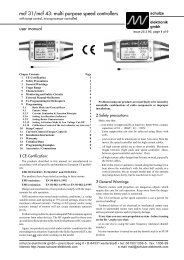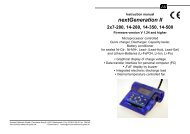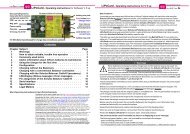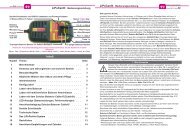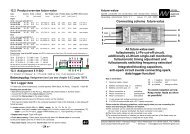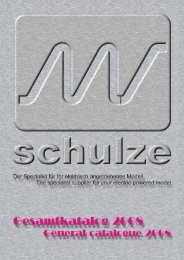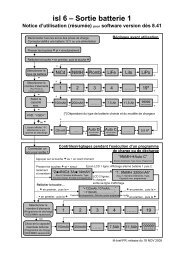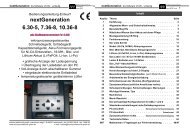ecolader: rapid discharger/charger series - Schulze Elektronik GmbH
ecolader: rapid discharger/charger series - Schulze Elektronik GmbH
ecolader: rapid discharger/charger series - Schulze Elektronik GmbH
Create successful ePaper yourself
Turn your PDF publications into a flip-book with our unique Google optimized e-Paper software.
Page 22 <strong>ecolader</strong>: <strong>rapid</strong> <strong>dis<strong>charger</strong></strong>/<strong>charger</strong> <strong>series</strong><br />
8.16 Discharge current<br />
Description:<br />
This function is used to select the maximum<br />
possible discharge current which the <strong>ecolader</strong><br />
is to use for discharging.<br />
Any current value above 10 A can be<br />
achieved using a separate discharge load resistance<br />
(accessory) plugged into the <strong>charger</strong>.<br />
The discharge load resistance is rated at<br />
0.40 Ohm, and is ideal for a standard 20 A<br />
discharge with a 6-cell pack. The resistance<br />
provides the basic load at the start of the<br />
discharge process, and the internal discharge<br />
current sink maintains a constant<br />
software-controlled 20 A discharge rate as<br />
battery voltage falls off.<br />
Activating the menu point:<br />
Press the akku x button.<br />
Select value:<br />
Press the + or - button.<br />
Value range:<br />
Battery 1: 300 mA ... 6 A ... 10 A ... 32 A.<br />
Battery 2: 150 mA ... 4 A ... 5 A.<br />
Battery 3: 100 mA ... 1 A ... 2 A.<br />
Confirm value:<br />
Press enter<br />
Interrupt:<br />
Press esc<br />
Note:<br />
The actual discharge current may be lower<br />
than the value set, depending on the number<br />
of cells.<br />
When the discharge load resistance is in<br />
use, the discharge current may be higher<br />
than the value set if the Ohm value of the<br />
discharge load resistance does not permit a<br />
lower current value. The minimum discharge<br />
current can be calculated from the formula:<br />
I = U / R. Example: a "pushed" 6-cell pack<br />
when freshly charged has a voltage under<br />
load of slightly less than 8 V. With our standard<br />
0.40 Ohm discharge load resistance<br />
this produces a minimum discharge current<br />
of: 7.8 V / 0.40 Ohm = 19.5 A.<br />
The <strong>ecolader</strong> software does not switch on<br />
the external discharge load resistance when<br />
battery voltage is above 10.5 V to guard<br />
against overload.<br />
8.17 Min. discharge voltage<br />
Description:<br />
This function is used to set the termination<br />
voltage of your battery during the discharge<br />
process.<br />
Activating the menu point:<br />
Press the akku x button<br />
Select value:<br />
Press the + or - button.<br />
Value range:<br />
automatic:<br />
The <strong>ecolader</strong> calculates the final discharge<br />
voltage from the number of cells in the pack<br />
and the discharge current in use.<br />
or:<br />
Battery 1, Battery 2: 500 mV ... 10 V<br />
Battery 3: 1 V ... 10 V<br />
in 500 mV increments<br />
Confirm value:<br />
Press enter<br />
Interrupt:<br />
Press esc<br />
Notes:<br />
If you are using the fixed limit values you<br />
may have to enter different limit values with<br />
different numbers of cells and different discharge<br />
currents.<br />
For a given number of cells, the automatic<br />
circuit sets the termination voltage lower the<br />
higher the discharge current is set. The<br />
baseline voltage for the calculation is 0.7 V/<br />
cell.<br />
In the automatic setting the calculated termination<br />
voltage can be read off during or<br />
after the discharge (and charge) process in<br />
the top line of the LCD screen when you call<br />
up the menu point.<br />
Connecting the discharge resistance and batteries<br />
schulze elektronik gmbh • prenzlauer weg 6 • D-64331 weiterstadt • tel: 06150/1306-5, fax: 1306-99<br />
internet: http://www.schulze-elektronik.com e-mail: mail@schulze-elektronik.com



